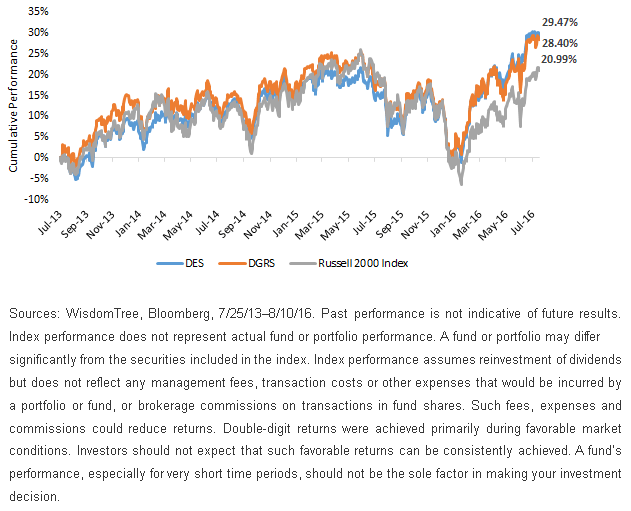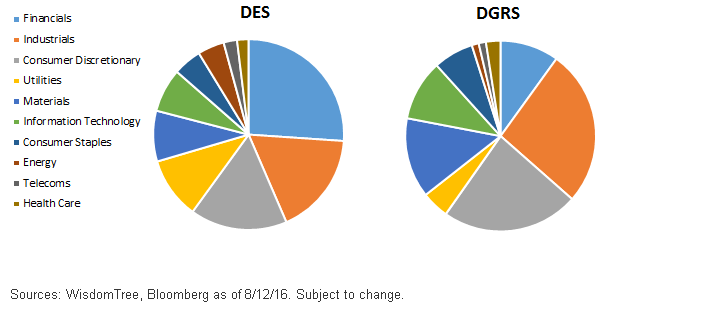Small Cap Dividends and Quality Adding Value


 Click here for standardized performance of DES.
Click here for standardized performance of DGRS.
Dividends in Small Caps?
Many have ignored mid- and small-cap dividend opportunities. One explanation for this is that when one looks at market cap-weighted indexes and goes down in size from large to mid- to small caps, one tends to see dividend yields decrease from 2.1% to 1.7% to 1.5%, based on the S&P family of indexes on August 12.1
The story completely reverses, though, when looking at a dividend-weighted index family.
Shifting from a cap-weighted universe to a dividend universe, one increases the dividend yield moving from large caps to mid-caps to small caps. The dividend yields on a dividend-weighted Index from WisdomTree increased from 3.0% to 3.2% to 3.5% for the WisdomTree LargeCap Dividend Index, the WisdomTree MidCap Dividend Index and the WisdomTree SmallCap Dividend Index.2
One explanation for this is that in a cap-weighted universe that includes non-dividend payers, there are more companies in “growth” stages that are using their capital to grow—or even just to break a profit, in many cases, for an index like the Russell 2000.
We have recently discussed how the typical small-cap company in the Russell 2000 has been a serial share issuer, as 20% of the Russell 2000 tends to be allocated to unprofitable stocks that need to raise capital to fund their growth. This has led to as much as a 2% drag in terms of how much earnings have to grow just for the
Click here for standardized performance of DES.
Click here for standardized performance of DGRS.
Dividends in Small Caps?
Many have ignored mid- and small-cap dividend opportunities. One explanation for this is that when one looks at market cap-weighted indexes and goes down in size from large to mid- to small caps, one tends to see dividend yields decrease from 2.1% to 1.7% to 1.5%, based on the S&P family of indexes on August 12.1
The story completely reverses, though, when looking at a dividend-weighted index family.
Shifting from a cap-weighted universe to a dividend universe, one increases the dividend yield moving from large caps to mid-caps to small caps. The dividend yields on a dividend-weighted Index from WisdomTree increased from 3.0% to 3.2% to 3.5% for the WisdomTree LargeCap Dividend Index, the WisdomTree MidCap Dividend Index and the WisdomTree SmallCap Dividend Index.2
One explanation for this is that in a cap-weighted universe that includes non-dividend payers, there are more companies in “growth” stages that are using their capital to grow—or even just to break a profit, in many cases, for an index like the Russell 2000.
We have recently discussed how the typical small-cap company in the Russell 2000 has been a serial share issuer, as 20% of the Russell 2000 tends to be allocated to unprofitable stocks that need to raise capital to fund their growth. This has led to as much as a 2% drag in terms of how much earnings have to grow just for the  Diversify Your Dividends with Small Caps
One of the more popular active dividend-growth strategies in the market was recently closed to new investors. One benefit to utilizing an index-based approach is that the broad cross-section of companies included allows for great investment capacity.
As investors re-examine how they obtain their dividend exposure in the growth side of the dividend market, we’d encourage them to consider small-cap dividend payers as an underowned segment that can help to diversify and provide differentiated exposure from other popular dividend strategies.
1Source: Bloomberg.
2Sources: WisdomTree, FactSet as of 8/12/2016.
Diversify Your Dividends with Small Caps
One of the more popular active dividend-growth strategies in the market was recently closed to new investors. One benefit to utilizing an index-based approach is that the broad cross-section of companies included allows for great investment capacity.
As investors re-examine how they obtain their dividend exposure in the growth side of the dividend market, we’d encourage them to consider small-cap dividend payers as an underowned segment that can help to diversify and provide differentiated exposure from other popular dividend strategies.
1Source: Bloomberg.
2Sources: WisdomTree, FactSet as of 8/12/2016.Important Risks Related to this Article
Dividends are not guaranteed, and a company currently paying dividends may cease paying dividends at any time.
The Global Industry Classification Standard (“GICS”) was developed by and is the exclusive property and a service mark of MSCI Inc. (“MSCI”) and Standard & Poor’s (“S&P”), a division of The McGraw-Hill Companies, Inc., and is licensed for use by WisdomTree Investments, Inc. Neither MSCI, S&P nor any other party involved in making or compiling the GICS or any GICS classifications makes any express or implied warranties or representations with respect to such standard or classification (or the results to be obtained by the use thereof), and all such parties hereby expressly disclaim all warranties of originality, accuracy, completeness, merchantability and fitness for a particular purpose with respect to any such standard or classification. Without limiting any of the foregoing, in no event shall MSCI, S&P, any of their affiliates or any third party involved in making or compiling the GICS or any GICS classifications have any liability for any direct, indirect, special, punitive, consequential or any other damages (including lost profits) even if notified of the possibility of such damages.
There are risks associated with investing, including possible loss of principal. Funds focusing their investments on certain sectors and/or smaller companies increase their vulnerability to any single economic or regulatory development. This may result in greater share price volatility. Please read the Fund’s prospectus for specific details regarding the Fund’s risk profile.

Jeremy Schwartz has served as our Global Chief Investment Officer since November 2021 and leads WisdomTree’s investment strategy team in the construction of WisdomTree’s equity Indexes, quantitative active strategies and multi-asset Model Portfolios. Jeremy joined WisdomTree in May 2005 as a Senior Analyst, adding Deputy Director of Research to his responsibilities in February 2007. He served as Director of Research from October 2008 to October 2018 and as Global Head of Research from November 2018 to November 2021. Before joining WisdomTree, he was a head research assistant for Professor Jeremy Siegel and, in 2022, became his co-author on the sixth edition of the book Stocks for the Long Run. Jeremy is also co-author of the Financial Analysts Journal paper “What Happened to the Original Stocks in the S&P 500?” He received his B.S. in economics from The Wharton School of the University of Pennsylvania and hosts the Wharton Business Radio program Behind the Markets on SiriusXM 132. Jeremy is a member of the CFA Society of Philadelphia.

